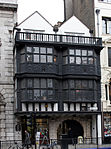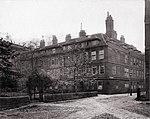Fleet Street

Fleet Street is a major street mostly in the City of London. It runs west to east from Temple Bar at the boundary with the City of Westminster to Ludgate Circus at the site of the London Wall and the River Fleet from which the street was named. The street has been an important through route since Roman times. During the Middle Ages, businesses were established and senior clergy lived there; several churches remain from this time including Temple Church and St Bride's. The street became known for printing and publishing at the start of the 16th century, and it became the dominant trade so that by the 20th century most British national newspapers operated from here. Much of that industry moved out in the 1980s after News International set up cheaper manufacturing premises in Wapping, but some former newspaper buildings are listed and have been preserved. The term Fleet Street remains a metonym for the British national press, and pubs on the street once frequented by journalists remain popular. Fleet Street has a significant number of monuments and statues along its length, including the dragon at Temple Bar and memorials to a number of figures from the British press, such as Samuel Pepys and Lord Northcliffe. The street is mentioned in several works by Charles Dickens and is the home of the fictional murderer Sweeney Todd.
Excerpt from the Wikipedia article Fleet Street (License: CC BY-SA 3.0, Authors, Images).Fleet Street
Fleet Street, City of London
Geographical coordinates (GPS) Address Nearby Places Show on map
Geographical coordinates (GPS)
| Latitude | Longitude |
|---|---|
| N 51.5138 ° | E -0.1105 ° |
Address
Ye Olde Cock Tavern
Fleet Street 22
EC4Y 1AA City of London
England, United Kingdom
Open on Google Maps










